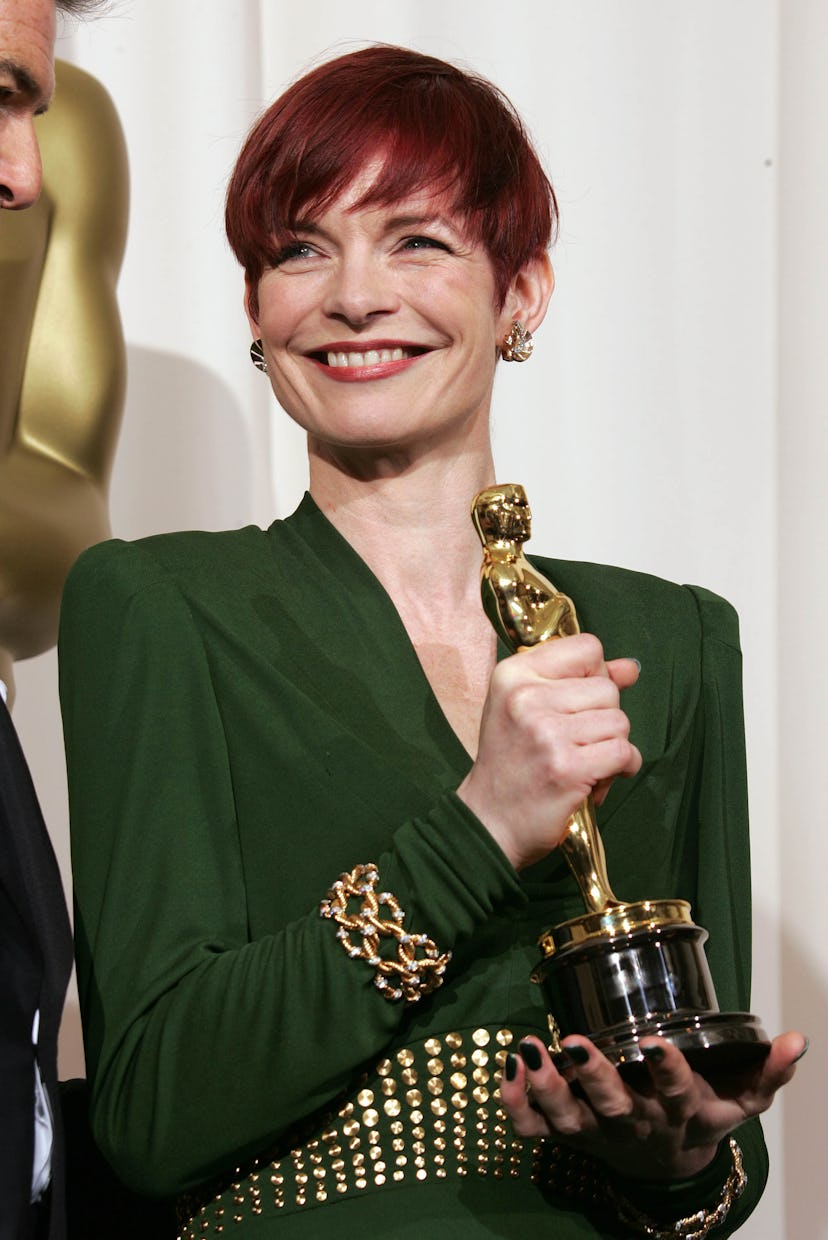Costume Designer Sandy Powell On Dressing Martin Scorsese’s Leading Women, and 15 Years of Collaboration
“Men are no less vain than women,” and more pearls of wisdom from a three-time Oscar winner.

It was 1999, and Sandy Powell had just won the Academy Award for Best Costume Design for her work on John Madden’s Shakespeare in Love when she got the call. Martin Scorsese wanted to meet with her, she was told. Would she receive a script for a film to be shot in Rome?
She would. That script turned out to be 2002’s Gangs of New York, and, for geographic purposes, Scorsese wanted a European costume designer to work on his 19th century epic. (Powell is based in London.)
“Before I knew it, I was embarking on this massive project that ended up being much bigger than anybody anticipated,” she said. “It was just a massive job, and it sort of grew — the script changed constantly, and the scenes got bigger, and the shoot went on and on and on.”
That’s not to say it was an unworthwhile experience. Gangs of New York inaugurated more than 15 years of collaboration between Powell, now 56, and Scorsese, 73. Their work has spanned pictures like The Aviator (for which she won her second Oscar, in 2005), Hugo, Shutter Island, and Wolf of Wall Street, many costumes from which are now on display in “Scorsese,” an exhibition at the Australian Center for the Moving Image.
The exhibition has moved from Berlin to Turin to Paris, collecting more material and archives along the way — the Melbourne show is, at least in terms of Powell’s work, the most comprehensive yet. (She hadn’t visited yet as of earlier this month, though she plans to travel to Melbourne later in the summer.) When we spoke, Powell was in the midst of a shoot in New York for a new Todd Haynes film, Wonderstruck, based on the second novel by the writer behind Scorsese’s Hugo. (Haynes is another frequent collaborator; Powell was nominated for her 12th Oscar for her work on 2015’s Carol.)
But the costumes on display in Melbourne are just a fraction of her career’s work: “Sometimes it’s tragic. Sometimes they just disappear,” she said, adding that costume rental companies buy them up and redistribute them to extras on subsequent productions. (This was the fate of several of the garments from Shakespeare in Love, among others.) “I had my own personal little archive, which is how they were easily available.” Powell offered up Cate Blanchett’s mustard-yellow frock from The Aviator and Daniel Day-Lewis’s oxblood coat from Gangs of New York for the exhibition. “If I had to save two from the fire …”
The yellow Katharine Hepburn dress is based on a design from the actress’s 1940 film The Philadelphia Story, but Powell’s inspirations don’t stay in the period in which she is working. When designing for Cameron Diaz in Gangs of New York, Powell drew from a recently purchased a Yohji Yamamoto skirt, which esulted in the “stylized look of … the Gang girls.” Bill the Butcher, Day-Lewis’s character, became a 19th-century Keith Richards.
Scorsese, too, is never shy about offering his own references: “Always, always with Marty, there’s a bunch of films to watch,” she said.
“Marty’s very interested in clothes,” Powell added. “He responds well to men’s clothing in particular. Marty is a clotheshorse, himself.” And, though she couldn’t recall an occasion where she had to start a costume from the ground up on any film, she recalled that Scorsese became “obsessed by ties” during Wolf of Wall Street, and she frequently found herself offering up different options to pair with various suits.
“Quite often, on set, especially on something like Wolf of Wall Street, if Leo [DiCaprio] comes onto set with a new suit, the first thing Marty does is feel the cloth, or feel the label,” she explained.
From the gritty streets of Gangs of New York to the eerie netherworld of Shutter Island, men tend to outnumber their female counterparts in Scorsese’s films. The leading ladies that do occupy the screen — Cate Blanchett as Katharine Hepburn, Margot Robbie as Naomi Lapaglia, Michelle Williams as Dolores Chanal — are enigmatic but charismatic. They stand out. Yet Powell said gender has little effect on her job.
“Leading ladies or leading men, there’s no difference,” she said. She added later, “Men are no less vain than women. People tend to talk about ‘leading ladies’ as being either glamorous or vain, and men aren’t. Well, it’s just not true. Men are exactly the same. They have as much vanity and as many insecurities. They’re all the same breed.”
Photos: Costume Designer Sandy Powell On Dressing Martin Scorsese’s Leading Women, and 15 Years of Collaboration
Sandy Powell wins an Oscar for Best Costume Designer for The Aviator, here, in Hollywood, California, February 2005. Photo by Carlo Allegri/Getty Images.
Sandy Powell attends the 88th annual Academy Awards in Hollywood, California, February 2016. Photo by Getty Images.
Sandy Powell with Cate Blanchett at the 18th annual Costume Designers Guild Awards in Beverly Hills, California, February 2016. Photo by Getty Images.
Leonardo DiCaprio and Cate Blanchett in The Aviator, 2004. Photo courtesy Sikelia Productions New York.
Cate Blanchett’s mustard dress from The Aviator. Photo by Didier Messens/WireImage.
Props from Gangs of New York, 2002. Photo by Deutsche Kinemathek/M. Stefanowski.
Costume illustrations for Gangs of New York from the “Scorsese” exhibition. Photo by Didier Messens/WireImage.
Installation view of the ACMI “Scorsese” exhibition. Photo courtesy ACMI.
Installation view of the ACMI “Scorsese” exhibition. Photo courtesy ACMI.
Installation view of the ACMI “Scorsese” exhibition. Photo courtesy ACMI.
Asa Butterfield and Martin Scorsese on the set of Hugo, 2011. Photo by Sikelia Productions New York.
Exhibition section “New York.” Photo by Deutsche Kinemathek/M. Stefanowski.